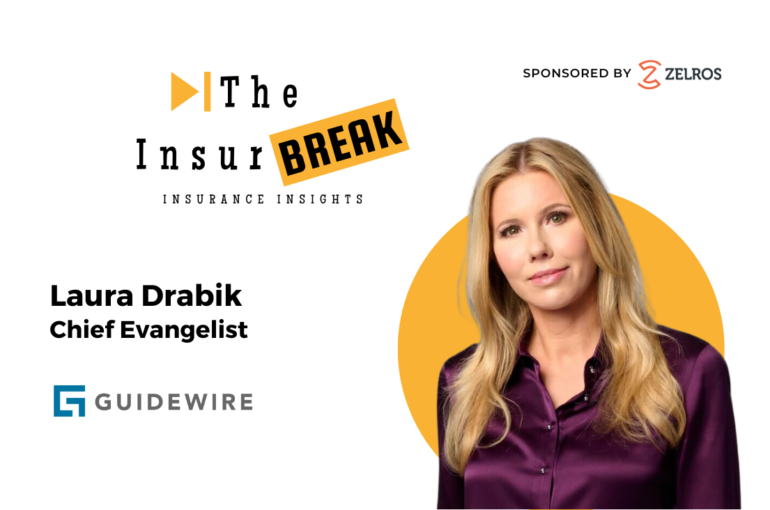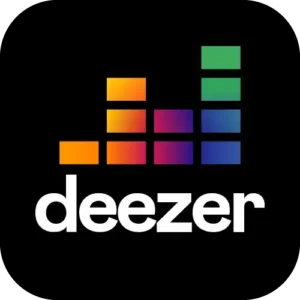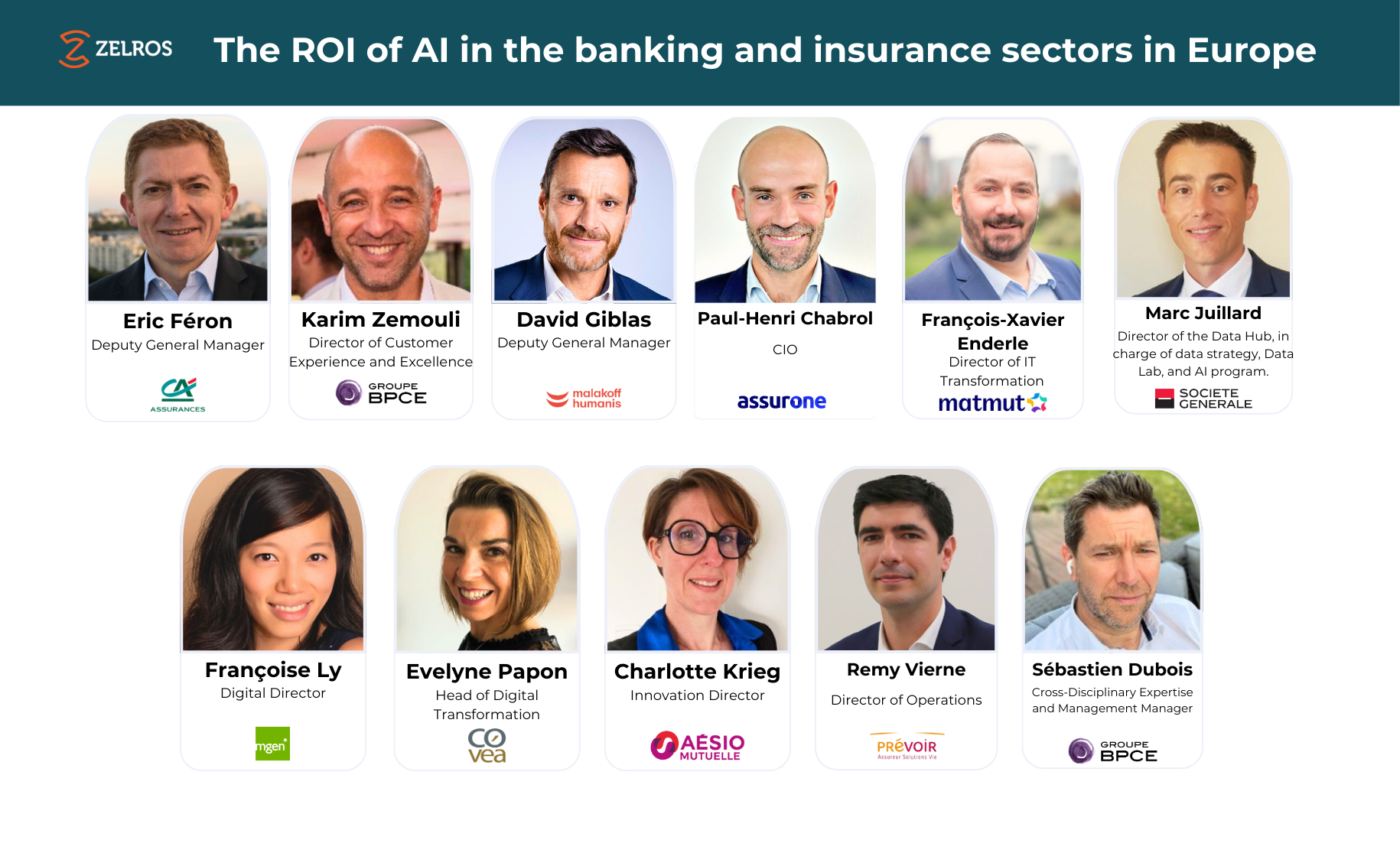From Collaboration to Innovation: How InsurTech is Reshaping the Insurance Landscape

Listen to the Insurbreak podcast on:
- The complexities in the insurance-buying process and the importance and the importance of incorporating human interactions with online resources
- The importance of making the insurance buying process easily understandable to increase visibility
- Integrating InsureTech solutions into operations to extend the lifecycle & visibility of offerings
Why am I willing to make a large purchase for an airplane ticket online? And I don’t think twice about it?…When we make more digestible products, make it easier to understand, there’s more visibility into what’s happening behind the scenes. I think you will see numbers increase.
Ash: You’re tuning to the InsurBreak Podcast. It’s the podcast about the latest and greatest trends in insurance. I’m your host, Ash, and I invite you to join us as we interview experts and executives in insurance covering innovative practices, technology advancements, and insight into the future of insurance. This podcast is sponsored by Zelros. Zelros is an AI software solution for insurance to hyper personalize the customer buying experience with insurance recommendations across all channels, boosting client acquisitions, cross-sell and up-sell.
In this episode, we sit down with Laura Drabik and discuss how InsurTech startups changed the way traditional insurers operate, how data is being used to improve underwriting and claims processes, and what some of the challenges traditional insurers are facing to fully integrate InsurTech solutions into their operations. Make sure to stick around until the end to hear about which InsurTech solutions are helping insurers reach new customers and expand their offerings.
Ash: She is a globally recognized property and casualty insurance thought leader, Ted Talk, presenter, subject matter expert, and most importantly, Chief Evangelist at Guidewire Software. We are joined today by Laura Drabic. Laura, thank you for being with us today!
Laura: Thank you for having me.
Ash: To begin with, Laura, can you maybe give us some insight into your background, how you got started in insurance?
Laura: I actually started my career many years ago working for the largest insurance company in the world, both on the claims and then on the agency side of the business. Ash, after a few years of gaining some boots on the ground experience in the insurance industry, I then transitioned into working as a consultant for a couple of very large firms and then have spent the last couple of decades working in the insurance software industry specifically.
Ash: What was your first role in insurance?
Laura: My first role in insurance was working as an adjuster. And you know what, Ash? I wouldn’t trade it for the world. It provided me with so much experience and insight that I still leverage today how to read people, how to listen, how to investigate all very helpful traits in current positions.
Ash: What is your current role and responsibilities now?
Laura: Before I mention what I do now, allow me a moment to outline how I actually started. So I joined Guidewire as one of the early employees working in sales when we were pre IPO with less than ten customers and one solution, which was claim center. Now we have over 500 customers. We’ve expanded into policy and billing, and we also offer digital and data solutions. So now that you know that my current role as Chief Evangelist will probably make more sense. So externally I serve as the brand ambassador, evangelizing our story, our journey, industry innovation themes that I see within the market. And I also serve as the hub for industry intelligence and direction. And one thing that I’m particularly interested in, that’s part of my responsibilities is that I launch and lead our InsurTech incubator which is called the InsurTech Vanguards.
Ash: What kind of companies are you investing in? Obviously InsurTech. But I mean is there more specific than that?
Laura: We are interested in early stage InsurTech startups. One of the requirements is we’re looking at those startups that would help to evolve the functionality that we offer integrating to our core. And then the second element is they can’t compete with our core and then our goal is to actually incubate them into full fledged partners and integrations to our insurance suite platform.
Ash: Very cool. It sounds very exciting, I mean probably one of your something that you enjoy doing, I assume.
Laura: I absolutely do. And the reason why I think is it’s exciting, it’s entrepreneurial working with these startup, the startup leaders, but also because I started in insurance, it’s fun to think about how the early days of Laura could have been helped boots on the ground, working in either claims or agency or working with our policyholders. It’s just really exciting to see how the industry has evolved in general through them.
Ash: So in your opinion then, how have InsurTech startups changed the way that traditional insurers operate? And what advantages do they bring to the industry?
Laura: Let me back up a moment and then I promise you I’ll address this question. So during the first quarter of 2022, InsurTech clocked the highest participation in early stage capital investment ever recorded. And it’s easy to see why their advances in artificial intelligence, mobility, data analytics and other technologies really help to transform our industry. Insurtechs don’t just change our industry though. I think they really help carriers to evolve it. So in the early days Ash, insurers used to see InsurTech as competitors. But things have changed, thankfully. Now InsurTech brings different innovation ideas, perspectives to the table, they bring different ways of working an entrepreneurial spirit and they really allow carriers to offer new services that empower consumers or digitize payments and more, which in the end really helps the policyholder. So when you combine that with what insurers offer, which is regulatory expertise, industry deep dive knowledge, historical experiential data and reliability and a foundation to the customer lifecycle, the two of these together they create just incredible whole new value propositions.
So now instead of competition, it’s really about collaboration. And I think that the two main benefits is that to the policyholder; is they’re getting improved service because of this partnership. They’re getting omnichannel experience and personalized products rates and coverages and fresh new products that better suit the needs of our industry and our consumer today. And then on the flip side of that, the carrier benefits through collaboration, by looking or becoming like their innovation leaders. And then I’ll leave it with this. And this is something I looked up yesterday. I was writing a blog on how one can use, insurers can leverage the InsurTech vanguards. And there’s the stat from Accenture, and it calls out that the revenue gap between innovation leaders and laggards in the P&C sector could top 37% by the end of this year. So as much as 200 billion in revenue will be driven by new risk products and services between now and 2025. So insurers can capitalize on this, and then, of course, the policyholder benefits from what they create.
Ash: Yeah, and just out of curiosity, by the way, we were talking to Tiffany from Nationwide on our last podcast, and they say that sometimes they develop technology in house. And I’m just curious, are you seeing insurers try to develop technology in house? Or are they collaborating more with Insurtech companies, Insurtech focused companies, or what’s that like?
Laura: I see both. So a lot of insurance carriers in the early days started these innovation garages, if you will, someone making like the HP approach of the early days of HP. But there are so many brilliant ideas out there and fresh young minds that are seeing tech and insurance differently. I see it now as more of a collaboration, but I think it’s both. But what I am seeing a trend with is the carriers, especially the large ones, bringing those innovators in house. So bringing some of those InsurTech in house and experimenting with them. But again, it’s both, which is positive because that means it’s collaborative.
Ash: Speaking of articles, Drabik Digest, your blog, you mentioned in one of your articles that one key advantage of the InsureTech ecosystem is the ability to access and leverage new data sources. Could you expand on how this data is being used to improve underwriting and claims processes? And what kind of impact that’s having on the industry? I think everyone probably listening to this will understand and agree with the statement that ecosystems are foundational today’s most innovative operating models. And more importantly, tomorrow’s. So take it, for example, usage based pay as you drive auto coverage or motor coverage, depending upon which part of the globe you’re located, it’s predicated on ecosystems. It doesn’t work without an ecosystem. And that ecosystem spans telematics, mobile connectivity, automobile or smartphone manufacturers, and more. All of these partners working together and tied into, hopefully, an insurer’s core system like Guidewire. So for this model to work, Ash, it requires these new forms of data from these integration points that I just mentioned. So all of this data input, it allows the insurer, most importantly, to personalize their pricing, their underwriting, to fit every single risk. And in addition to that, it also helps them to improve their claim servicing because this data can be used not only to automatically trigger a claim or alert emergency services, et cetera. All of this data can be used to automate and then move a claim along in a very personalized way, including, like I said, scheduling services, creating accurate reserves. I mean, that’s really important. Auditory bodies make sure the carriers are creating these accurately and then even automating claims payout. But this is a result of these new data sources coming in from these new data entry areas and in particular IoT.
Ash: Yeah, and also people are more willing to share data, personal data, to save on insurance. I’m talking about underwriting, save on insurance. Like for example, my dad is not as willing to share maybe information as I am newer generation. So I feel like also people are just more willing to share data and information to save on insurance.
Laura: I couldn’t agree more. Ash and in fact, we just ran a survey and the result of that showed that a significant like in the 60s percentile of consumers that we interviewed said they would share data with an insurer if it meant or if it resulted in personalized pricing. So I think you’re spot on.
Ash: Insurers are still struggling to fully integrate InsureTech solutions into their operations. What are some of the challenges facing traditional insurers and what steps can they take to overcome them and remain competitive in a rapidly changing environment?
Laura: So, believe it or not, we actually hear this a lot and it is why, or it’s the inspiration for our Partner Connect and our insurer tech Vanguards programs. Both of them. And again, Vanguards is our early staging incubator which feeds the Partner Connect program. But what our customers tell us, which is the carriers, is they’re looking for help with understanding the Insurtech landscape and also vetting it and curating it. So that is our goal with developing both of these programs. So in both programs we curate, we vet, we search out industry leaders like Zelros, of course, which is one of our valued partners and also for our Partner Connect program. They’re responsible for building out integrations to our core insurance suite solution. So the carrier, our customer, can turn on and offer these new value props to extend the service. They provide their policyholders or just innovate on what they’re already delivering. So again, we hear this problem a lot. We see it as an opportunity. It’s why we develop these two programs instance or near instant on off of these InsurTech value propositions to extend the lifecycle. And these pre built integrations, I should add, they dramatically reduce the time to market for getting these value props from insurance carriers minds or ideation to actually in the field to their consumers.
Ash: And this is kind of a tangent question, but I’m just curious. Do you feel like the macroeconomics, the general how the economy is doing, does that have an impact too on insurers mindsets, how they decide to spend their money and whatnot?
Laura: Yeah. Without a doubt. And there’s two sides of that coin, right? It’s how it’s affecting the insurer tax, which I don’t think I need to explain there. It’s been pretty obvious with some exit and some mergers and then the reduction in investments. And then there’s the flip side of that with the carriers. Ash, I run these innovation sessions at headquarters and the most frequently requested session with me, I’ve never seen numbers like this before, is carriers coming from around the globe to hear about our insurer tech vanguards, to see where they can put investment dollars because right now their dollar goes farther with Insurtech investment. So we see carriers that are taking this as an opportunity, the economy as an opportunity and looking at where they can invest in Insurtech.
Ash: As more and more consumers turn to online marketplaces for their insurance needs, how is the InsureTech industry responding to the shift in consumer behavior? And are there any particular InsureTech solutions or technologies that are especially well suited to the marketplace model? And how are they helping insurers to reach new customers and expand their offerings?
Laura: So with regards to online marketplaces for insurance needs, and specifically I was looking at quoting and buying as a consumer, whether it’s personal or commercial online. And I think there’s something important here to call out. And this stat hasn’t changed in probably five years. And that is 70% of consumers, they’re going to go on and get a quote online or to a marketplace, but less than 30% are actually going to purchase online. Over the last three years, online issuance hasn’t increased that much. In fact it was 25% three years ago, it’s now at 30%. And I think what’s key here is the following. So rather than calling out company names, I’m going to talk a little bit about value props that resonate and then companies that fall into that I think are really well suited. And that is omnichannel service options is essential. And that means that a policyholder, they’re going to start their journey potentially online, but they have to be able to conveniently, excuse me, switch to an advisor, a human, maybe even a chat bot. But definitely there has to be the human option. And that’s important. Or what’s important here is that the information that’s collected either via the digital web front end or via the chat bot, it has to be available to the human advisor to pick up and fulfill the transaction. A policyholder will not tolerate, not today’s policyholder, having to repeat information already collected. And a really good example of this, of course consumer scalable example is Amazon. You can start on the phone, you can transition over the web and you can go to the human and they always have the most up to date information on you and on your shopping cart. So that’s number one, that’s key. And number two is personalization Consumers expect personalization as a standard feature in every single industry. And again, I was writing a blog, a different blog, and I came across this metric from McKinsey a week ago. But organizations that provide best in class personalization can see increases of 25% in revenue. So, I mean, it makes financial sense to do it. But what’s important here for personalization, and I’m sure you’ll agree, is data and analytics to create a very tailored policy and coverage flow or journey, depending upon who the consumer is. And again, Zelros is an excellent example of a value prop that delivers personalization via the recommendation engine. And then the third thing I want to highlight in the final is integration to a modern insurance platform is key. Okay, clearly I’m biased here, but I worked in the industry and now I work for a modern core solution. And it’s imperative that carriers have one objective source of the truth for the product, for the customer, for the rates, so that the carrier can trust at all times that they have the freshest, highest quality data to run analysis on. So anyway, it’s those three things that I think are absolutely key to your question and any value props that ensure text that fall into those three I think will do very well in our market.
Ash: Do you think that people don’t pull the trigger necessarily online, on online marketplaces because it’s just human nature needs somebody there? Or do you feel like there will be a time where people will pull the trigger? Like that number will be closer to 70, 80%? Just out of curiosity how you feel about that?
Laura: I think about it this way, and that is why am I willing to make a large purchase for an airplane ticket online? And I don’t think twice about it. Why will I buy a pair of jeans off of Amazon and not think twice about it? And it could be the same price as insurance, if not more. Some jeans can be really pricey, women’s jeans. But the point is, I trust that this brand, Amazon, I trust that this brand, United Airlines, which is what I use, has my best interest in that. I trust that they will refund, if I’m not happy with the product that I’ve purchased, that they have security in place that will protect me when I’m using a credit card or my online payment form. But I have faith in them and in their technology. So I think when insurance carriers get there, I think that will increase the numbers. But also number two, and it could be even number one, but number two is insurance is complex. I’ve worked in the industry for over 20 years and I still don’t buy my complex products online. I’ll buy a warranty online, I’ll buy renters insurance online, but I will not buy life insurance because I have something really valuable to lose. And there are so many complexities to it that I might start my search online, but I would always want to be able to end with a human because I have something really important to lose. So just when we get one and two figured out for insurance, make it more digestible products, make it easier to understand, there’s more visibility into what’s happening behind the scenes. I think you will see numbers increase.
Ash: Yeah, but there’s always going to be that, like you said, the life insurance and the things that are like you have to pay a lot for and that’s kind of very personal, that you’re always going to need a human there.
Laura: You hit on it, Ash, which is the personalization. And really what the human provides is that personalized journey for the end consumer. And for certain products, it is really essential. Unless we break them down, the carrier breaks them down into something that’s really digestible, visible, easy to understand.
Ash: Very cool. Okay, so our next topic is DEI. We always ask each speaker about diversity, equity and inclusion. What are your thoughts on dei and tech? And maybe if you have a personal story to share, that would be great.
Laura: Yeah, and I think it’s a positive that this question is even being asked in your podcast. So first of all, thank you for asking about it. And secondly, it highlights how important this issue is in every single industry, including insurance. So I’m going to let our audience into a little secret, which is, I started insurance over 20 years ago and in fact, there might be three decades in there. And when I started, believe it or not, it wasn’t very diverse, it was very homogeneous, it was a sea of sameness. I’m very happy I’m over the moon to see that it has changed significantly in particular over the last five years. And I think it has everything to do with carriers actively implementing and supporting DEI programs. Because Ash, this is so important. This statement is that insurance is for everyone. It’s not just for a homogeneous group of people. So we need diversity in insurance to build better insurance products that are better suited for the new consumer so that adjusters can handle claims more empathetically and personalized to a diverse claimant, as well as provide in general more personalized service throughout the entire insurance lifecycle.
Ash: That makes a lot of sense. I mean, regardless of the gender or where you come from, like you said, everybody needs insurance. Most people in the US drive cars and a lot of people get life insurance still and we all need medical insurance. So it’s like every human being needs insurance and we’re all diverse. So it’d be great to have a diverse group of people to cater to that or to be in an industry where they are helping a diverse group of people. So that makes a lot of sense. Talk to me about Girls in Tech? I know you’re a board member there. Could you tell us more about the work that the organization does and maybe what you do to promote gender equality in the industry.
Laura: The mandate of this global nonprofit is to increase diversity in tech. Although we have the name girls, the word girls in tech, it’s actually targeted at women that are 20 to 40. So anyone can join even those above 40. It’s not just about getting more women though, in tech roles I want to highlight. It’s really about getting more diversity or diverse women into tech roles. And to accomplish this, if you go to the website, you can see we run all these different programs. So we do it through education. Education for the members. We have hackathons for social good. We focus on things like breast cancer, et cetera, things that are really important to women. And then we hack on them. We have master class sessions, which are experts, trained by experts, leading experts in certain subject matters. We have mentoring programs. And then also on the flip side of that, for companies, we have job boards and we have the Girls in Tech conference, which is across the globe. People will come to the girls in Tech conference. We have thousands of people that typically attend men and women. And it gives companies visibility to a diverse set of women a diverse set of women to hire or potentially employ.
Ash: It’s so inspiring to hear that you’re doing this kind of work and it’s part of your extracurricular, I’m assuming. By the way, how do you measure the impact of these programs? Is it like how many jobs you’re placing or how do you measure that?
Laura: Yeah, and that’s something that we do struggle with because you’re right, ultimately it should be how many women are joining the tech industry, in the countries where we have chapters. So we have 30, I think it’s 38 different chapters across the world. So we do look at are we affecting any of those metrics? But if you actually bring it down to more of a granular level where we can see impact is we look at things like how many sponsoring companies we have. So we have Nike, we have Pega, we have Guidewire sponsoring us. So every year we look to see if we can grow the sponsoring company. So that’s one of our metrics. We also try to understand which programs are resonating and are being consumed by how many of our women that are accessing them. And then we use it to refine our approach in the future. And then also our job boards and are they leading to hiring opportunities? So that’s something where we really have to rely upon the sponsoring company to feed us back those metrics. But I think those are the three elements that we look at. But overall, Ash, you hit it on the head, which is it’s how many women are joining the tech industry?
Ash: So the final question is, if you could go back 20 years, what advice would you give your younger self?
Laura: I think I have three pieces of information that I would give myself or recommendations. It would be, number one, get a mentor. It doesn’t matter if it’s female or male. Find someone who knows you and is in a position that can help guide you where you want to go in your career. So, number one, get a mentor. Number two, find your voice. Too often, when I was younger, I would actually give my ideas to a male counterpart or to my boss and have them represent the ideas. And it wasn’t until my boss at Guidewire, Steve Sherry, he said, Laura, that’s it. You’re representing your own ideas from this point forward. Have faith. So, number two, find your voice. And number three, sit at the table. Too often, there’s that outer ring. It’s like the Kuiper belt. When you walk into a conference room, you got the sun in the middle, which is the conference table. And then there’s a Kuiper belt circling around our solar system, and that’s where a lot of our women sit. And I get that because you might not be confident, and it provides a barrier and some type of protection, if you will, from that inner core. But the thing is, if you want to be heard and you want to be able to say important things and share your ideas, you need to sit at the table.
Ash: Yeah. And it’s also on allies to create a space to make people comfortable, to help with those things that you said. So I feel like people like yourself, who are actively trying to get people involved, making a comfortable space for people to be able to kind of step into that circle, if you will.
Laura: That’s an excellent point, Ash. As all of us as leaders, when we are sitting at the table, leave a chair open. And when you see someone come in that might be Junior or might be not comfortable at the table, bring them, invite them in, have them take that seat, and make sure that to your point, Ash, make certain that they’re heard, like, pull your chair back so that they can be seen or specifically ask them their thoughts on a particular idea or some topic of discussion. But you raise a really valuable point. It’s all about US leaders to be allies and advocates.
Ash: This podcast is sponsored by Zelros. Zelros is an AI software solution for insurance to hyper personalize the customer buying experience with insurance recommendations across all channels, boosting client acquisitions, cros-ssell and upsell.
Thank you for tuning in to the Insurbreak podcast. Join us next month as we interview another insurance executive to gain insight on innovative practices, technology advancements, and what the future of the industry looks like. See you.




